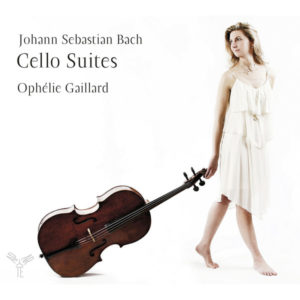
Ophelie Gaillard. Bach Cello Suites (Aparte) Rec.2010 APO17.
Introduction.
This recording of the suites is actually the second made by Ophelie Gaillard at the ripe old age of 36! I am led to believe from reviews that the well received first one was more fiery than this version. In any event the one under review feels like a well thought out performance suggesting she has become comfortable with her views on the pieces.
As at the time of this review I had recently carried out one for Gaillard’s French compatriot Anne Gastinel, I thought it might be worth drawing out a few comparisons.
The sound of the two recordings both share strengths in the presence given to the cellos, creating a realistic soundstage for the listener. However, unfortunately, both proved equally prone to prominent tapping on the fingerboard.
Additionally, in Gaillard’s version the dreaded heavy breathing intrudes (just check out the Sarabande of the 4th Suite..). It made me wonder if both ladies were a bit too partial to the Gauloises! However, a less flippant explanation is I think that the acoustic improvements provided by recording techniques in recent decades have not paid enough attention to these (for me at least) unwanted side effects.
The recording.
As regards performance comparisons with Gastinel, that version felt like it was being recreated along the way, whereas I felt Gaillard had a clear picture in her mind of where she wanted to go from the start. Her reading itself is more leisurely in feel. From the very start in the first Prelude it has a lilting quality to it that I found attractive. In fact this may be my favourite version to date of this movement. (Only Queyras, another French cellist, coming close, but in a quite different reading).
The set though is not ponderous in any way as the quicker movements such as the Courantes romp along quite nicely. Also the Bourrees (for example in Suites 3 and 4) have a real bounce to them. In the slower movements though there is air around the notes which are allowed to decay naturally and effectively. Gaillard’s 5th Suite Sarabande is worth a mention too. Here we again find the lilting quality with a sense of ebb and flow. This I found interesting as many versions strive for a greater sense of stillness and awe throughout. You pays your money you takes your choice (I choose both!).
Conclusion.
I couldn’t finish without commenting on the 6th Suite. Gaillard takes the rarer option of using a piccolo cello with it’s 5th string. In fact this seems to be the instrument requested by Bach in the manuscript copied by his second wife Anna Magdalena. What it does is ease the cellist’s burden in the high lying passages. Academic debates aside on what instrument was intended for the suites, I found the 6th Suite rendering very refreshing. There is generated some lovely sweet playing and an overall lightness to the sound. The standard cello struggles to achieve this.
Overall I rate this version as having more plusses than minuses , and well worth exploring.
Mark